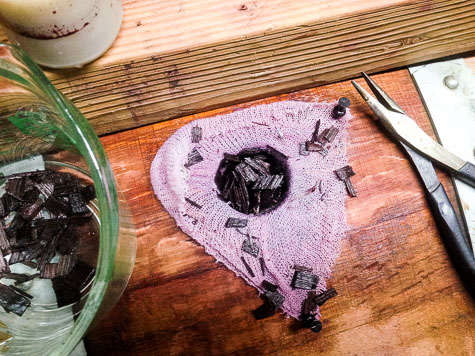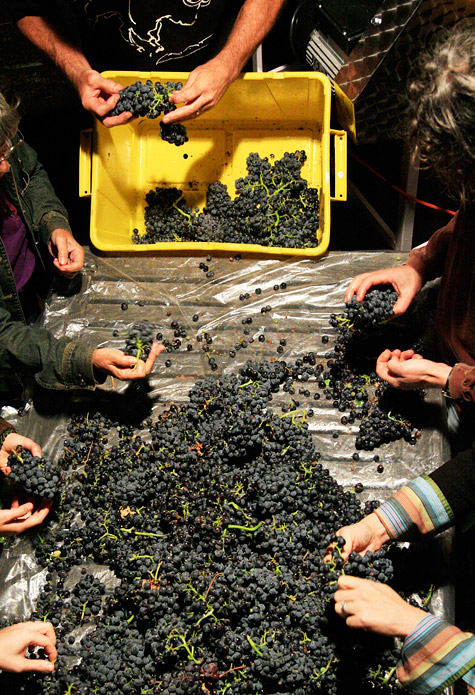Archive for the 'Winemaking' Category
This won’t hurt a bit

Scalpel! Sutures! Drinking straw! The sweet tedium of performing an oak-ecomy on a barrel of Cabernet Sauvignon.
About a week ago, I felt like the Cab could use just a bit more depth, and for this varietal at least, what oak can bring out in its fragrance. So I wrapped a few ounces of French oak chips in a cotton mesh bag and suspended it in the barrel. A little oak goes a long way — and I want this Cab to taste like Cab, not oak — so I checked it every other day until the balance I wanted to achieve seemed to have come to pass.
Then the trick is to get it out, the oak chips now expanded to wider than the barrel opening. I’m sure there’s a smarter way, but this is how I do it: pull out as much of the bag as possible, snip the end off and splay it around the hole. Then grab bits at a time, continuing to pull the bag further out.
Interesting for about 4 minutes, then damn tedious. At least you’re surrounded by the fragrance of toasted oak when you do it.
No commentsRACKING: Mourvedre and Franc
…off gross lees
Comments are off for this postStill fermenting!
Incredibly, the rosé still hasn’t finished fermenting — nearly 5 months after it started. The hint of CO2 in the head space does give the game away, but I’d assumed that was simply residual. So I checked the sugar: 1.75%, oceans away from dry. And it tastes it, too. Lovely nose, but too sweet in the mouth, like strawberry jam.
A long, cool fermentation is apparently just the thing for whites (and semi-whites like rosés), so I haven’t been too concerned. And the CO2 tells me the yeasts are still alive in there — it’s just been too cold to do much of anything, something with which I think we can all sympathize. But it’s time for these guys to get off the couch, shed the Snuggies, and finish the job. Unlike last year, I’d like to get this rosé sealed up early enough that it’s over bottle shock by the time the first warm Saturday afternoon rolls around.
So we’ll wrap the carboys in our electric mattress pad and apply just a hint of heat. I’m a little worried that malolactic fermentation will also jump-start (while malo’s just the thing for reds, it can muddy and over-soften whites), but que sera, sera. Malo seems to proceed much more slowly than primary fermentation, so with luck, the yeasts will race far ahead of the malo bugs and we can seal up a lovely rosé before things get too mellow.
No commentsGrenache by the numbers
холни масиOur numbers are back from the lab, and they look better than we thought. 26.9 brix is high, but a lot better than the 29 we’ve been getting on the hydrometer. And look at that pH: ideal acidity!
The tricky bit will be the fructose and glucose number, which translates to approx 17.7% alcohol — fine for powering machinery, but not for powering a decent meal. So we’ll water back 1.5 brix, see how it feels, and then maybe notch it back another brix or so near the end of fermentation. I’m told by a winemaking hero of ours that our open-top fermenters will probably also dissipate some of the alcohol, so with luck, we’ll cruise into bottle around 15%. Not exactly what you’d call an “elegant” wine, but with the right massage it’ll be in balance, which is all we really want, anyway.
Les numeros:
brix 26.9 degrees glucose + fructose 298 g/L pH 3.47 titratable acidity 5.8 g/L tartaric acid 4.44 g/L L-malic acid 2.93 g/L potassium 1610 mg/L alpha-amino compounds 135 mg/L ammonia 72 mg/L yeast assimilable nitrogen 194 mg/L (as N)
Considering that sugar, a couple of Gs wondered whether all that sorting might have been a bad idea. Elaine and I did some math last night and calculated that assuming we culled 100 lbs of fruit from what we got, the cull would have had to be an average of 14 brix to have swayed the overall sugar by 1 bx. 14 brix is the sugar content at veraison, when the grapes just start turning color, so while we did toss some green ones, the majority were well into color. So, suffice it to say that what we tossed couldn’t have affected the sugar significantly. But because unripe fruit is about more than sugar, it still probably improved the overall flavor.
No commentsCrushing Grenache

The pace is picking up here at our subterranean lair. Cabernet Franc and Pinot Noir are looming in the next few days, but last week, it was Grenache — the first time we’ve tackled this Rhône varietal. I made the trip with Garagiste Whit in mid-80s Ford F-150 which was loaned to us by Bill, a warm and generous friend of Erik’s now retired from the carpentry business. Pulling into the vineyard in that rig made us feel a little less like the yahoos we are.
The vineyard manager warned us that the sugars might be high, but we saw a lot of unevenness in the clusters, so we set up our first-ever sorting table (pictured above). As we later learned, the sugars were indeed high, but I’m convinced that culling the surprising percentage of unripe and sometimes green berries will make this a purer wine. After all, grapes aren’t just about sugar, and the bitter, vegetal flavor of unripe ones can really swerve a wine.
In any case, since we’ve never made Grenache, I can’t say whether the fruit was typical, or whether this oddball year made it this way, but this may give Pinot Noir a run as our most challenging harvest. The sorters diligently scanned every cluster for leaves, green berries, and the telltale pink/magenta tint of unripeness. Keen eyes even pulled out a little bunch rot, though the harvest was overwhelmingly healthy.
But now it’s safely soaking; probably start fermenting mid-week. More pics just a click away…
Read more
